Chesapeake & Ohio Canal Dam Number 5 and Power Plant (Honeywood Dam)
Introduction
Text-to-speech Audio
Images
Power Plant and Dam
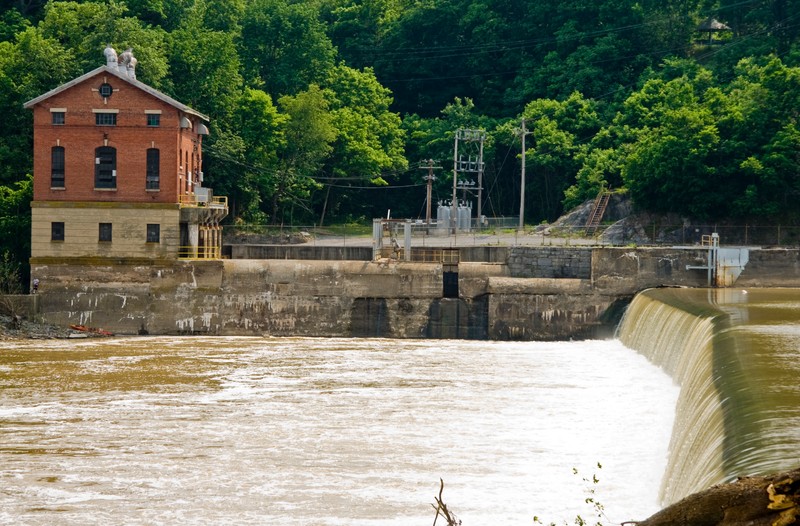
The mill building and dam, circa 1904
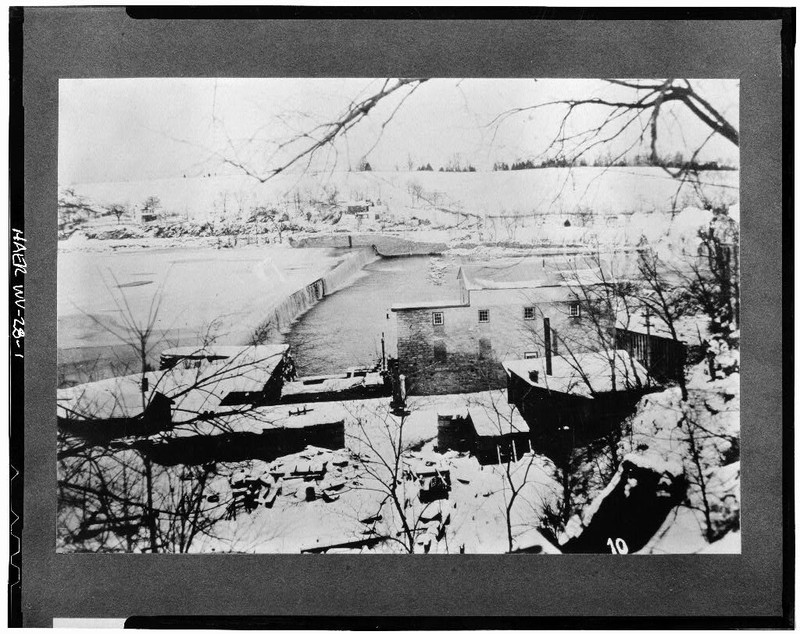
The interior of the power plant with Martinsburg Power Company Superintendent H.B. Shoemaker
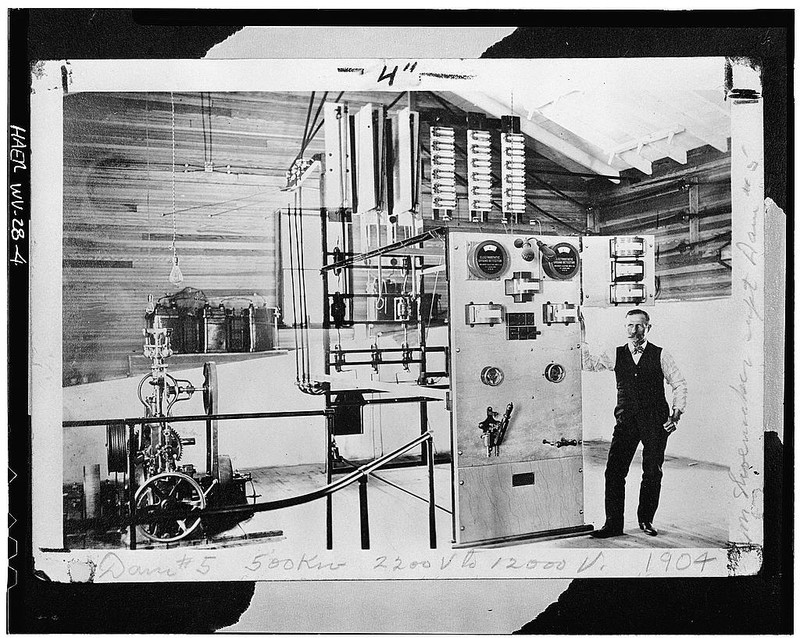
Inside the power plant, 1980
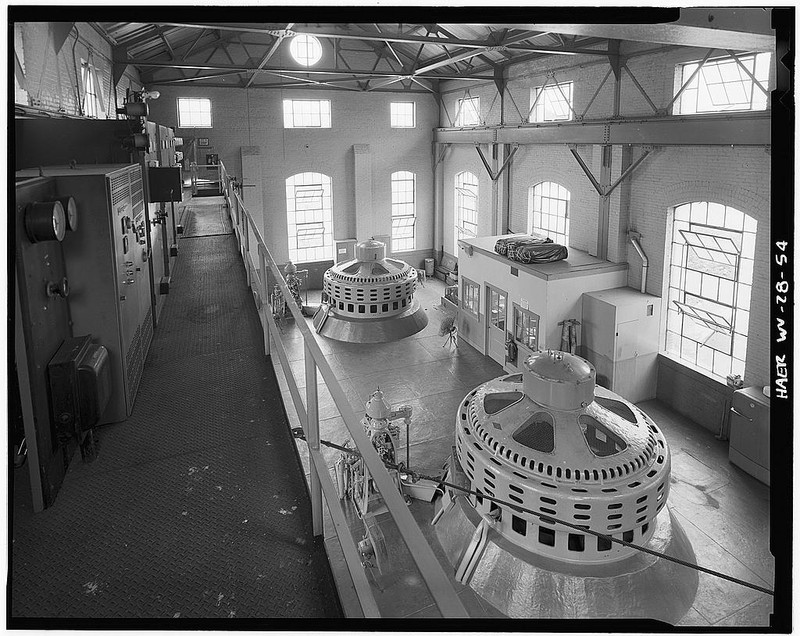
Looking towards WV - the power plant, river, and dam, 1980
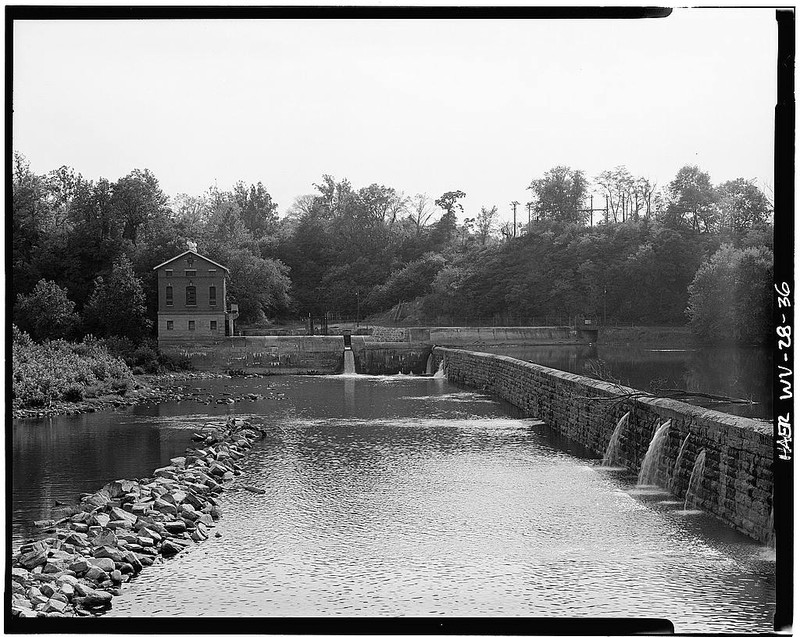
The river and power plant, 1933
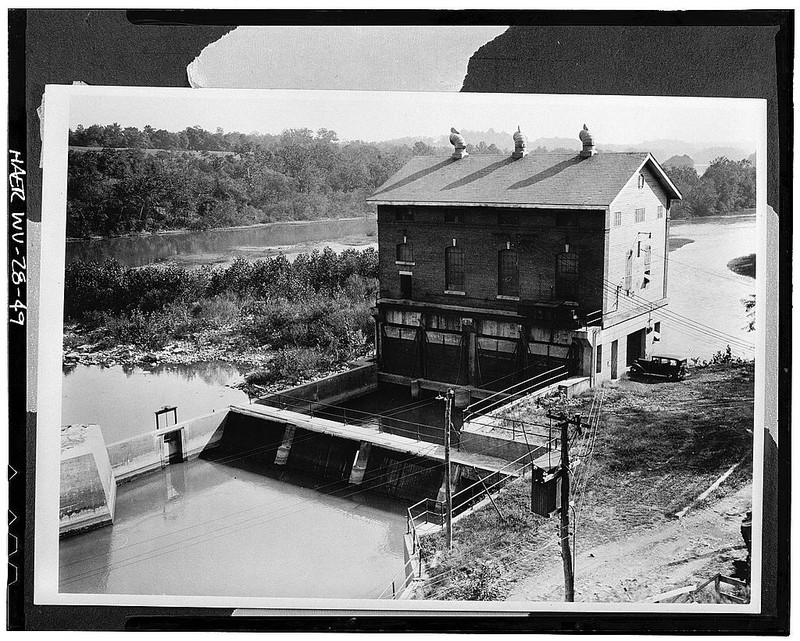
The power plant and substation during a flood, April 1937
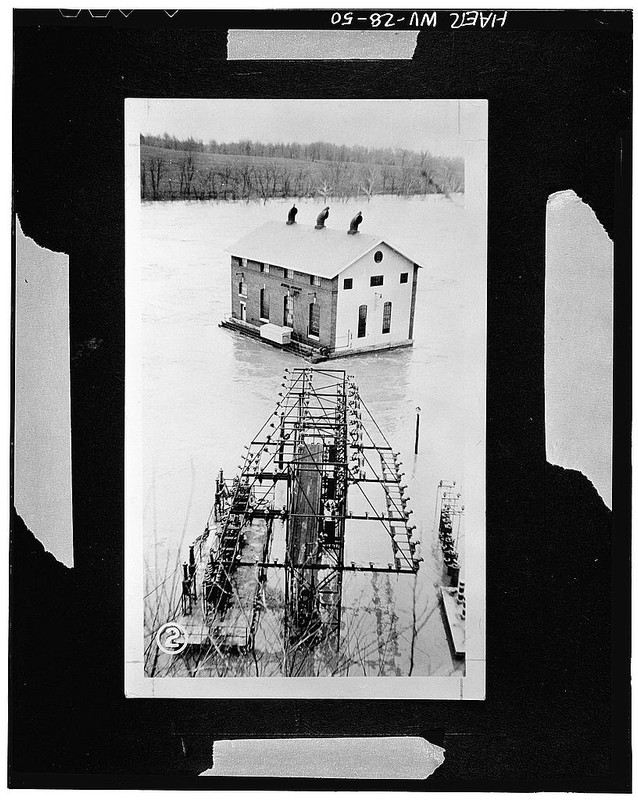
Backstory and Context
Text-to-speech Audio
Construction of the 184.5-mile-long C&O Canal, designed to be a navigable alternative to the Potomac River traversing the distance between Washington, D.C., and Cumberland, Maryland, began in 1828. However, it took twenty-two years before the massive project (it included a 3,118-foot-long tunnel) was finished, and by that time it was partially outdated by the B&O Railroad. It was used to bring grain, coal, and various other resources from rural producers to urban consumers, and did meet with some success. Mules would walk along the towpath and pull boats filled with these goods (and the captains and their families) down the canal. However, the canal company fell deeper into financial trouble as industries began to turn solely to the railroad for transportation needs and as it was forced to pay for many expensive repairs – the canal was plagued with seventeen destructive floods by 1996. The 1889 flood caused a million dollars in damage and drove the company bankrupt; the canal was afterwards operated by subsidiaries of the company’s main creditor, the B&O Railroad. The 1924 flood sounded the death knell for operations on the aging canal. It was allowed to run down before being sold to the government in 1938 and declared a National Historical Park in 1971.
The canal had six dams and guard/inlet locks along its length which impounded water and controlled its flow to fill the canal. Lock tenders would keep watch for boats and operate the locks around the clock. (The lockhouse, where they resided, still stands on the Maryland side of the river.) Dam Number 5, located between Falling Waters, West Virginia, and Clear Spring, Maryland at mile 106.6 of the canal, was built out of timbers in 1835. The wooden dam was soon determined to be too weak to withstand repeated flooding; however, construction of its 700-foot-long stone replacement was not completed until 1857 because floods kept interrupting work.
The dam was an important strategic target during the Civil War; it stood near the border and ensured the operability of the canal, which was one of the Union’s main resource arteries. Stonewall Jackson, assigned to the Shenandoah Valley in late 1861, soon began planning to destroy it. He sent a subordinate, Major Elisha Paxton, to attack Dam No. 5 on December 7th; though Paxton was initially able to drive away Union forces with his artillery and accomplish several hours’ worth of work on tearing apart the dam, he eventually retreated back to Martinsburg, (West) Virginia. Jackson himself then attempted an attack on December 16th. This battle continued for 5 days of back-and-forth action. Sometimes Jackson would be able to successfully deploy teams down to the icy water to work on tearing apart the dam, but then he would be forced back to the (West) Virginia side of the river. Union soldiers took cover in the drained canal. Jackson stationed sharpshooters in the mill building next to the dam before the building was destroyed by Union cannon fire. Eventually, on the afternoon of December 20th, he left and returned to Martinsburg. While he wrote in reports, “the recent break in Dam No. 5 will destroy any vestiges of hope that might have been entertained of supplying Washington with Cumberland coal by the Chesapeake & Ohio Canal,” boats were running again on the 21st.[4]
Canal operations – especially around the locks and dams – were not without dangers and even fatalities. On May 1st, 1903, the Canal Towage Company’s (a B&O subsidiary) Boat No. 6, piloted by Captain Joseph Kime and headed to Cumberland, traversed the lock and entered the river during a heavy gale. It broke free of its mule team and was blown over the 25-foot-high dam. The Captain was launched 15 feet straight up and a lock tender, Harry Newkirk, was thrown from the boat. In the cabin, the Captain’s wife was knocked unconscious, while his 8-year-old daughter fell out the window and his 10-year-old daughter was pinned between the stove and the beds. Boats came quickly to rescue the four survivors; the Kimes’ youngest daughter had perished in the water. The elder daughter suffered a broken arm, Newkirk lost several teeth, and Captain Kime died the next afternoon at the train station on his way to Cumberland.
Edward Colston first purchased the water rights from the dam in 1835 and set about constructing its first connected factory, the Honeywood flour mill (from which the dam received its unofficial name). The building soon burnt down; its replacement was destroyed in the Civil War, as mentioned earlier. A new building was built, and the mill became a pulp grinding mill and paper mill in the late 19th century. Electricity came to Berkeley County, West Virginia, in 1890 and the building was turned into a hydroelectric power plant by the Martinsburg Power Company in either 1891 or 1904. It was torn down in 1917 and replaced by a new power plant, completed the next year, which still stands today. According to the Historic American Engineering Record, “The plant epitomizes the predominant…hydroelectric technology in use at the time of its construction.”[21] The power plant was used by Potomac Edison Electric Company, then by its new parent company Allegheny Power and its merger partner, FirstEnergy. The plant was sold to Harbor Hydro Holdings LLC, a subsidiary of LS Power, as part of a bulk deal in 2011.
Sources
1) About the C&O Canal; About, C&O Canal Association. Accessed March 2nd 2020. http://www.candocanal.org/background.html.
2) Attack on Dam Number 5; Raids; Civil War Encyclopedia, Georgia's Blue and Gray Trail Presents America's Civil War. September 12th 2009. Accessed March 2nd 2020. http://blueandgraytrail.com/event/Attack_on_Dam_Number_5.
3) "Bad Wreck on the Canal." The Shepherdstown Register (Shepherdstown, West Virginia) May 7th 1903. 3. Chronicling America: Historic American Newspapers. Accessed March 2nd 2020. https://chroniclingamerica.loc.gov/lccn/sn84026824/1903-05-07/ed-1/seq-3/.
4) Barrett, Jason. Stonewall Assaults Dam No. 5. America's Civil War. September 1st 2000. 13th Massachusetts Volunteers. Accessed March 2nd 2020. http://13thmass.org/1861/index.html.
5) The Canal Arrives in Cumberland, National Park Service: Chesapeake & Ohio Canal National Historical Park. October 30th 2018. Accessed March 2nd 2020. https://www.nps.gov/choh/learn/historyculture/thecanalarrivesincumberland.htm.
6) Canal Construction, National Park Service: Chesapeake & Ohio Canal National Historical Park. February 8th 2018. Accessed March 2nd 2020. https://www.nps.gov/choh/learn/historyculture/canalconstruction.htm.
7) Canal History: Canal Era from the 1830s-1870s, C&O Canal Trust. Accessed March 2nd 2020. https://www.canaltrust.org/about-us/about-the-co-canal/history/canal-history-canal-era-from-the-1830s-1870s/.
8) Canal History: Canal Groundbreaking, C&O Canal Trust. Accessed March 2nd 2020. https://www.canaltrust.org/about-us/about-the-co-canal/history/canal-history-canal-groundbreaking/.
9) Canal History: Decline and Eventual Closing of the C&O Canal, C&O Canal Trust. Accessed March 2nd 2020. https://www.canaltrust.org/about-us/about-the-co-canal/history/canal-history-decline-and-eventual-closing-of-the-co-canal/.
10) Canal History: Flooding and Its Effects on the Canal, C&O Canal Trust. Accessed March 2nd 2020. https://www.canaltrust.org/about-us/about-the-co-canal/history/canal-history-flooding-and-its-effects-on-the-canal/.
11) Canal History: Role of the Canal During the Civil War, C&O Canal Trust. Accessed March 2nd 2020. https://www.canaltrust.org/about-us/about-the-co-canal/history/canal-history-role-of-the-canal-in-the-civil-war/.
12) Canal Operation, National Park Service: Chesapeake & Ohio Canal National Historical Park. February 8th 2018. Accessed March 2nd 2020. https://www.nps.gov/choh/learn/historyculture/canaloperation.htm.
13) The C&O Canal's Legal Status 1889-1939, National Park Service: Chesapeake & Ohio Canal National Historical Park. January 4th 2018. Accessed March 2nd 2020. https://www.nps.gov/choh/learn/historyculture/receivership-era.htm.
14) Dam 5/Guard Lock, C&O Canal Trust. Accessed March 2nd 2020. https://www.canaltrust.org/pyv/dam-5-guard-lock/.
15) Dam No. 5, Potomac River Guide. Accessed March 2nd 2020. http://www.riverexplorer.com/details.php4?id=825.
16) FirstEnergy Completes Sale of Eleven Hydroelectric Power Stations to LS Power’s Harbor Hydro Holdings, LLC, LS Power. February 12th 2014. Accessed March 2nd 2020. https://www.lspower.com/firstenergy-completes-sale-eleven-hydroelectric-power-stations-ls-powers-harbor-hydro-holdings-llc/.
17) Historic American Engineering Record. Index to Photographs - Dam 5 Hydroelectric Plant - HAER No. WV-28, Library of Congress. Accessed March 2nd 2020. https://cdn.loc.gov/master/pnp/habshaer/wv/wv0200/wv0221/data/wv0221cap.pdf.
18) Historic American Engineering Record. Dam No. 5 Hydroelectric Plant, On Potomac River, Hedgesville, Berkeley County, WV, Library of Congress. Accessed March 2nd 2020. https://loc.gov/pictures/item/wv0221/.
19) History of the Canal; About the C&O Canal; About Us, C&0 Canal Trust. Accessed March 2nd 2020. https://www.canaltrust.org/about-us/about-the-co-canal/history/.
20) McVey, John. FirstEnergy hydroelectric stations sold, The Journal. November 1st 2013. Accessed March 2nd 2020. https://www.journal-news.net/news/local-news/firstenergy-hydroelectric-stations-sold/article_6b95294f-cdbe-5f58-b92b-a1ebf1e4d5e4.html.
21) Scott, Charles. Written Historical and Descriptive Data - Dam 5 Hydroelectric Plant - HAER No. WV-28, Library of Congress. 1982. Accessed March 2nd 2020. https://cdn.loc.gov/master/pnp/habshaer/wv/wv0200/wv0221/data/wv0221data.pdf.
22) Wood, Don. Power Plant and Dam No. 5 (Honeywood Dam), National Register of Historic Places Inventory/Nomination Form, West Virginia State Historic Preservation Office. Accessed March 2nd 2020. http://www.wvculture.org/shpo/nr/pdf/berkeley/80004438.pdf.
23) Wood, Don. Historic Resources of Berkeley County, West Virginia, National Register of Historic Places Inventory/Nomination Form, West Virginia State Historic Preservation Office. October 17th 1979. Accessed March 2nd 2020. http://www.wvculture.org/shpo/nr/pdf/cover/64000958.pdf.
Wikipedia (https://commons.wikimedia.org/wiki/File:Dam_No._5_Potomac_River_1.jpg); CC BY-SA 3.0 (https://creativecommons.org/licenses/by-sa/3.0/deed.en)
HAER LoC (https://www.loc.gov/pictures/item/wv0221.photos.172764p/)
HAER LoC (https://www.loc.gov/pictures/item/wv0221.photos.172767p/)
HAERS LoC (https://www.loc.gov/pictures/item/wv0221.photos.172818p/)
HAERS LoC (https://www.loc.gov/pictures/item/wv0221.photos.172799p/)
HAER LoC (https://www.loc.gov/pictures/item/wv0221.photos.172812p/)
HAER LoC (https://www.loc.gov/pictures/item/wv0221.photos.172813p/)
